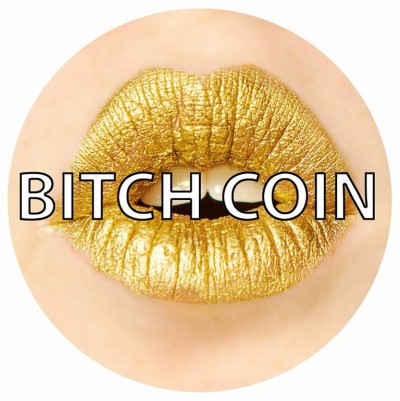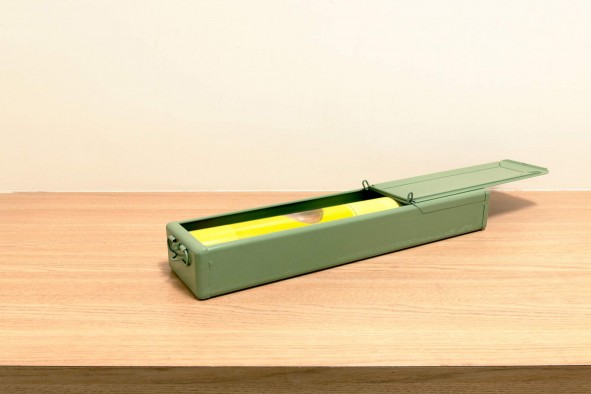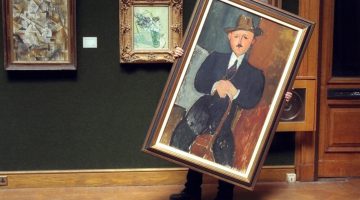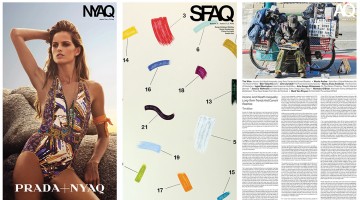In February, the artist Sarah Meyohas invented her own currency called “BitchCoin,” which she presented in collaboration with Where Gallery in Brooklyn, as part of their current exhibition Where 6: Prediction. The currency is used to trade the artistic production of Meyohas herself, so it is something of a closed circuit. The idea is that each BitchCoin, currently worth $100, would purchase a 25 square-inch segment of one of the artist’s current or future prints. It costs 25 BitchCoins to purchase a print. The artist is backing BitchCoins with photographic prints sealed in a vault, harkening back to the gold standard established in the wake of World War II. The parallel between contemporary photographs and gold bricks in a Federal Reserve vault is provocative, and current, now that art is perceived by many as an asset class. In fact, Meyohas means to offer BitchCoin on a currency-trading site when her exhibition concludes. The artist explains: “I would like to see an art market that allows collectors to invest in an artist as a value producer, rather than investing in a single piece. Artists and collectors are linked in a more symbiotic way.”1

BitchCoin, a digital currency developed by Sarah Meyohas. Courtesy of the artist.
It is tempting to read this as a publicity stunt, but there is a deeper problem that Meyohas alludes to regarding the relationship of artists to the contemporary market. BitchCoin is symptomatic of current transformations in contemporary finance that have an impact on the art market despite its miniscule size in relation to global asset trading. If Meyohas can invent an art-backed currency in order to link artists and collectors “in a more symbiotic way,” the terms of this linkage are derived from novel trading instruments. Why would an aspiring artist want to facilitate speculation on the value of her future production? On her website, she explains: “An artist’s work might fluctuate wildly on the market, changing hands between collectors several times without any permission of, or compensation to, the artist. BitchCoin gives Sarah Meyohas a stake in the supply, demand, and price of her own work.”2
In other words, the artist created BitchCoin in order to gain access to—and perhaps to create—speculation on her own work. This may seem crass at first glance but, upon further reflection, it is a transformative gesture that reclaims the financial mechanisms of the art market to the artist herself. Previous artists may have wanted to distance themselves from market forces but Meyohas justly seeks to have a stake in the market for her own art.
Everyone in the art world knows that it is a rare phenomenon to be able to live by virtue of one’s artistic production and those artists who succeed, do so because they are fiercely promoted by art world agents, be they dealers, collectors, or curators. In many cases, the artist is the primary force for their own self-promotion, but artists traditionally allow representatives to manage these affairs so that they can focus on their work. Or at least they used to. The problem with this model is not that marketing has become a necessary part of artistic life—it always has been and always will be—but the context of art collecting and artistic production have changed in the 21st century. Broad changes have occurred in the world of finance and the sale and purchase of assets of all kinds, including works of art. This trend has been called “securitization” or “financialization,” and while the implications of the terms are slightly distinct, they both address a wholesale shift in the nature of exchange.
According to John Lanchester, “Securitization is the process of turning something—and, in the world of finance, this could be pretty much anything—into a security, a financial instrument that can be traded as an asset.”3 His two examples are the “Bowie Bond” of 1997 and the Greek government’s effort to sell revenue from future ticket sales to the Acropolis in 2010. The Bowie Bond refers to David Bowie’s successful sale of ten years of future revenues due to him for the sum of $55 million. What both of these examples lay bare is that any potential future value can be turned into a security and sold to investors. As Bowie and Meyohas demonstrate in different ways, artistic production and the potential value generated thereby can be transformed into an asset that can be cashed out now.
Of course, a Bowie Bond or a BitchCoin can be exchanged any number of times as a security whose value fluctuates and is determined by the market more than whatever value one would have initially attached to the good or service it represents. Even though a work of art represents a one-of-a-kind commodity that cannot be easily exchanged like a stock or bond, by securitizing its potential future value, one is able to detach the particularity of the work from the risk or benefit it potentially carries and to exchange that potential in a market of other potential profits and losses. In this process, which amounts to trading derivatives, the work of art and the labor of the artist becomes commoditized in a way that even Marx could never have predicted.

Sarah Meyohas, Speculation, 2014. Unframed digital chromogenic print, 21 5/8 x 28 7/8 inches, edition of 8. Speculation is the first image to back BitchCoin. It is currently stored in safety deposit box #138 of HSBC, 110 William Street, New York, NY 10038. Courtesy of the artist.

Sarah Meyohas, Speculation, 2014. Unframed digital chromogenic print, 21 5/8 x 28 7/8 inches, edition of 8. Courtesy of the artist and Where Gallery.
This process is what Olav Velthuis and Erica Coslor have described as financialization, in which the art market becomes enmeshed in a series of financial instruments that are increasingly affected by the motives of actors operating in a variety of trading operations.4 In their article on the financialization of art, they conclude that the process is far from complete due to fundamental limitations in the art market such as a lack of liquidity among assets (artworks), the absence of continuous trading, and the lack of stable shared standards of value that would anchor the market. Despite these shortcomings, the authors conclude: “Failures can be seen as a natural step in the process of experimenting to find the correct instruments to simplify, standardize, and homogenize art, stripping each individual work of its distinctiveness and grouping categories of art together in order to make them comparable and commensurable.”5
Has art been financialized? Not quite yet, but soon. Velthuis and Coslor cite economists Rachel Campbell and Christian Wiehenkamp who put forward a proposal in 2010 for how to use credit default swaps—financial instruments that allow banks to sell potential profits to investors—to securitize art risk, but it is unclear whether such instruments are now in use or whether any art index can reliably serve as a guide to investing in art. However, there are investment schemes currently active in which funds are pooled to invest in the upper reaches of the art auction market and dealers could not participate in the resale market unless they could raise funds by leveraging their own art assets. In other words, art has not yet reached the point that it can be traded like stocks and any derivative trading on the art market may well be in a nascent phase. While artworks, particularly those in the postwar and contemporary markets, have increased in value considerably since the onset of the 21st century, the way these works are valued remains a mystery to most onlookers. The increasing values attract the attention of speculators and economists, but art funds—the most common art investment schemes—have very rarely succeeded at capitalizing on the record prices so often reported on the art auction market.
Following this line of thought, BitchCoin and the Bowie Bond are the exceptions proving that the art market remains a rarefied domain, and further that artistic labor cannot be commoditized. While this logic is compelling, there are reasons to doubt it. The most obvious one is that if the art market is a subset of the overall service economy, the exchange of artworks means engaging in contemporary finance, with all of the norms that apply to that domain. The art market does not exist in a vacuum and therefore derivatives trading will be part of any effort to finance the purchase of a work of art, as well as to insure it. Further, the fact that there is an uneven distribution of information about the art market means that a handful of agents are in a strong position of profiteering. The central players in the art market are themselves speculators or facilitators, which is why vice presidents of Christie’s and Sotheby’s are so often dropping out and going into business for themselves. Their asymmetrical advantage in the market does not prevent speculation as some economists claim, but encourages and facilitates it. Finally, most analyses of the art market investigate the consumer side—particularly the auction market—but the question of the relation of artistic production to finance has been underexplored.
Artistic production as a whole has shifted as a result of the market for contemporary art and it is clear that only certain forms of artistic labor produce value because only a handful of artworks are attractive to investors, compared to the number of works produced. This means that artists, even art students, begin their own derivative trading on the value of their own labor. By taking on loans to receive an education, art students have already entered the world of financialization because those loans are sold by banks as assets. If students then begin to think of how they may manipulate the market in order to succeed as an artist financially, they are themselves speculators attempting to determine which investment of their time will likely have the greatest value for them in the long run. They are trading on risk. If artists begin to imagine that pursuing a particular path of artistic production, like making paintings, yields greater returns than another, they are employing asymmetrical information to capitalize on the market’s inefficiencies. If an artist is lucky enough to succeed at making a living solely through artistic production, she had better have an eye on managing the value of her work should it go through the roof and crash like a speculative bubble.
Capitalism has changed and both the consumers and the producers of the art market must change with it. The story of securitization of art or the financialization of art markets is not exclusive to banks, investors, and collectors, but concerns artists as well. Though artists may not employ algorithms to determine coefficients, they are no less calculating when it comes to economic risk.
Visual artists have long served the needs of the wealthy and the powerful, but, in the art world, one believes that the contribution an artist makes to society is beyond valuation. This conception has been validated in a variety of forms, from the creation of the Louvre to the implementation of the WPA. When this ineffable contribution acquires a real valuation—when artistic work can be seen as more or less profitable—it is not simply that our views have become crassly materialistic, but that our metrics have changed and it is by value, not time, that we measure our progress whether as artists or as thinkers. If the simple gesture of creating an equivalence between a photograph and 25 BitchCoins strikes us as outlandish, it is because we have not fully accepted the implications of art as an asset under current economic conditions. Making a living from art is not like peddling credit default swaps, but, on some level, the same rules apply.
1) Becca Rothfeld, “’BitchCoin’ Currency Challenges the Way We Buy Art”, Hyperallergic (March 2, 2015).
2) bitchcoin.biz
3) John Lanchester, “Money Talks: Learning the Language of Finance”, New Yorker (August 14, 2014).
4) Olav Velthuis and Erica Coslor, “The Financialization of Art” in Karin Knorr Cetina and Alex Preda (eds), The Oxford Handbook of the Sociology of Finance, Oxford: Oxford University Press, 2012, pp. 471-487.
5) Ibid., p. 483.


